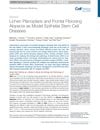Frontal Fibrosing Alopecia Is Associated With Dysregulation of Cholesterol Biosynthesis Pathways, Fibrosis, and Mast Cells
April 2019
in “
Journal of Investigative Dermatology
”
TLDR Frontal Fibrosing Alopecia involves disrupted cholesterol pathways, fibrosis, and increased mast cells.
The study on Frontal Fibrosing Alopecia (FFA) involved RNA sequencing of scalp biopsies from 18 FFA patients and identified three major dysregulated pathways: downregulation of steroid/cholesterol/fatty acid pathways, upregulation of fibrosis and hypertrophic scarring pathways, and upregulation of mast cell genes. Histological analysis confirmed increased mast cells in FFA lesions. Similar molecular changes were detected in non-lesional scalp, indicating early detection potential. Unique to FFA, there was upregulation of T cell activation and antigen presentation genes. The findings suggest that targeting these pathways with specific drugs, possibly combined with immunomodulatory treatments, could benefit patients with cicatricial alopecia, including FFA.





